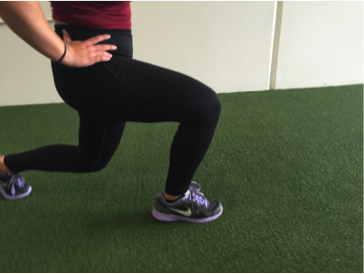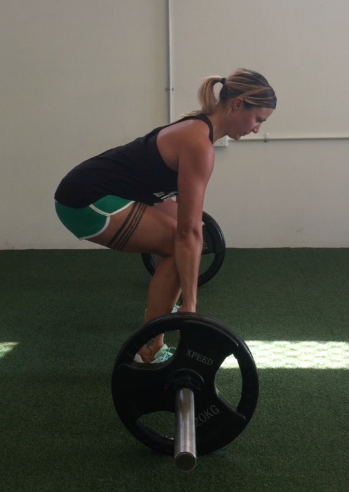Quad Dominance & Posterior Chain Development
Quad dominance & posterior chain development. These 2 areas that tie in very strongly with each other – so lets cover them both together - first quad dominance, and then posterior chain development. It is important to note here, that although this discussion is had very much from the female-player stand point, everything being discussed applies or is of value to the male player as well. However, quadriceps dominance is slightly more of a concern for female players, for reasons that will be covered.
What exactly is quad dominance? It’s pretty close to exactly what it sounds like. With quad dominance, female athletes (and females in general) tend to activate their knee extensors (muscles on the front of the upper leg) preferentially over their knee flexors (muscles on the back of the upper leg) to control knee stability.
"Quadriceps dominance is defined as an imbalance in strength, recruitment, and coordination between the knee extensors and knee flexors. Decreased hamstring strength relative to the quadriceps is implicated as a potential mechanism for increased lower-extremity injuries and potentially ACL injury risk in female athletes."
Donald A. Chu
In other words – or more simplified terms, quad dominance is a relative imbalance in work between the quadriceps down the front of the leg, and the hamstrings and glutes down the back of the leg, during various movements. This problem is far more common in women than in men, and is believed to be a strong contributor to not only knee pain, but also knee injury. As a result, a strong focus must be given to posterior chain development (which we are coming to) – both single-leg and double-leg – in the strength training program of a female player.

However, even in exercises where there is a stronger quadriceps component such as when squatting or lunging or performing step ups (as it is still important to strengthen in these patterns,) you can also work to keep such quadriceps dominance in check. Something really simple to cue yourself with every time you perform one of these exercises is to ‘keep your weight on your heels’ to activate the glutes as much as possible (rather than moving to the balls of your forefeet, which will be very quad dominant) as well as to ‘activate/flex the hamstrings’ during these movements too. These are 2 things that are so simple to do – particularly the staying on the heels – and when performed repetition after repetition, will make a big difference to this issue.
"Quad dominance – the action of the quadriceps can increase anterior shear at the knee joint, and in turn increase the strain on the ACL. This quadriceps-dominant muscle recruitment strategy is therefore potentially injurious to the ACL in female players."
Paul Gamble
We have covered this problematic ACL risk among female players elsewhere.
Now that you are aware of this, take note of this yourself now when you perform certain exercises, particularly lunges. Are you noticing yourself being excessively quad dominant? For example, are you finding you have the tendency for your knee to track too far forward when you lunge? Or are you finding that when you lunge or squat, you automatically have the tendency to shift your weight to your forefoot rather than your heel? These are 2 classic ways that you will see quadriceps dominance occurring in your training and your movement, so pay attention to these things, and take special care to look to counteract this with the simple cues that we gave before, as well as paying particular attention to developing the posterior chain – which we are coming to now.
Posterior chain development
The posterior chain is basically the ‘chain’ of muscles, tendons and fascia that run down the back of the body, starting up the top with the cervical extensors (neck) and working all the way down to the Achilles tendon. Unfortunately, when it comes to strength training and development, for a lot of people it’s a case of ‘out of sight, out of mind,’ where thanks to the mirror, there is that tendency to work a lot more on what can be seen in front us, rather than what is behind. Unfortunately, the posterior chain is at least equally as important as the anterior chain, and possibly even more important – especially as a female player. Lets have a look at a few key reasons why.
Poor upper body posture in females
Poor posture is a big problem for most people in todays society, even those who are active regularly, and generally speaking poor upper body posture is a bigger problem for females than males. This includes the rounded shoulders, slouching upper body and forward head. On top of the natural tendency that females have towards this posture, there are additional potential challenges that impact on this posture that males don’t face – namely pregnancy and footwear choice (high heels.) Both of these things will impact not only the posture around the pelvis, but also secondly higher up at the neck shoulders.
Rounded shoulders in particular are a problem, as when the shoulders are forward of their natural ideal alignment, they are unstable. And unstable shoulders in a sport like footy with so much tackling and marking and involvement of the shoulders, is a recipe for injury. You only have to look at how many guys you see with strapped up shoulders – and this is often as a result of unstable shoulders secondary to poor muscle balance around the shoulder. In other words, too much pushing based training such as bench press and other chest work, and a no-where near proportional amount of pulling work in the opposite direction. Over time what you have is imbalance around the joint, with the shoulder sitting forward of its proper alignment, and instability as a result.
So in short, correct upper body posture is key, and the vital component here to focus on is the strengthening of the posterior chain in this section.
Quad dominance
As just discussed, quad dominance is a relative imbalance in work between the quadriceps down the front of the leg, and the hamstrings and glutes down the back of the leg, during various movements. This problem is far more common in women than in men, and is believed to be a strong contributor to not only knee pain, but also knee injury. As a result, a strong focus must be given to posterior chain development – both single-leg and double-leg – in the strength training program of a female player.

Specifically this means conditioning the glutes and hamstrings in both double leg and single leg stances as well as ensuring that as many of these exercises integrate hip stability into the exercises as possible. Also important is working the hamstrings as a knee flexor (as in a Swiss ball hamstring curl), a hip extensor (as in a deadlift), and also a knee stabiliser (as in a single leg deadlift, where the hamstring must also assist to stabilise, thanks to only 1 leg being in contact with the ground.) In other words, the hamstrings and the associated stablisers must be trained in the tasks, movements and abilities that will be required of them in a game, not just be trained as muscles. For example, when we talk about posterior chain development, we don’t mean use a hamstring curl machine, as this will not achieve the aims we are looking for (stability ad movement, rather than a guided path.) Please note: this does not mean 'leg curls on a pin loaded machine are useless, period' - as everything has a place and a use (for example initial stage of rehabilitation, bringing a specific weakness up to speed, eccentric loading formats, etc.) It merely means that this isn't as effective as other means for what we are discussing.
"Hamstring work is particularly relevant to female players, for whom hamstring strength typically plateaus early in their development."
Vern Gambetta
"The training and retraining of hamstring muscles in non-functional patterns may explain the frequent recurrence of hamstring strains in athletes who rehabilitate with exercises such as leg curls on machines."
Mike Boyle
Knee stability
We touched on the hamstrings contribution to stabilising the knee in single leg movements just before, however additionally, the stability of the hips will also contribute to the stability around the knee too. This is because any instability around the hips and flow down to the knee, meaning the knee has to try to ‘pick up the slack’ from the hips and perform work that it isnt supposed to, and isnt designed to (have a look at the size of the pelvis, then have a look at the size of the knee joint.) This puts the knee at a greater chance of injury.
So what does this stable hips have to do with posterior chain development? What you will find with training for function, and working the body as a collective unit in certain movement patterns and goals, rather than breaking it down into parts like bodybuilding, is that many of the results from the training overlap with each other. That is, exercises that develop one thing, also positively develop another. This is why when we discuss a whole heap of things to work on, many readers are left thinking ‘when am I going to fit all these things in?’ Yet the reality is, with correct exercises, correct programming, and a specific approach to womens footy, you achieve multiple things together, rather than needing to do an infinite number of different exercises. And specifically here, much of hip stability based work also ties in with posterior chain development. As just one example, the single leg deadlift works to develop the hamstrings, as well as working on hip stability, as the stabilisers around the pelvis have a lot of work to do with only one foot in contact with the floor.


So don’t neglect the posterior chain. We have only just touched on a few points here, but we are only scratching the surface of these 2 topics. Posterior chain development is at least as important as the anterior chain, but it can be argued even more important – particularly for female players, thanks to its contribution to injury reduction – which is still the most underrated benefit from a functional approach to strength and conditioning. In Female Specific Strength & Power for Aussie Rules, we place a strong emphasis on the development of this posterior chain.
Strength Coach

